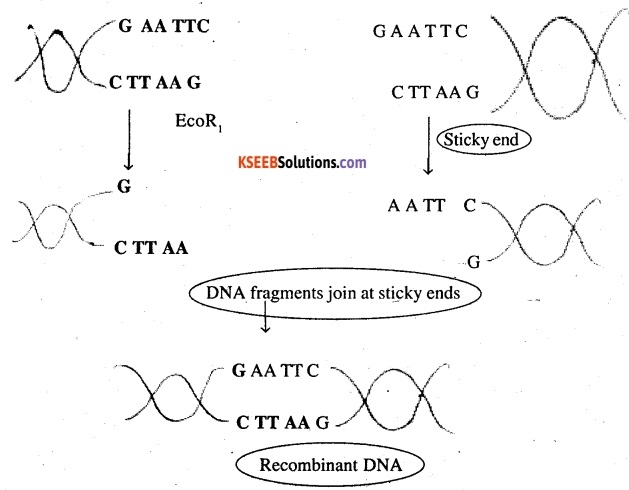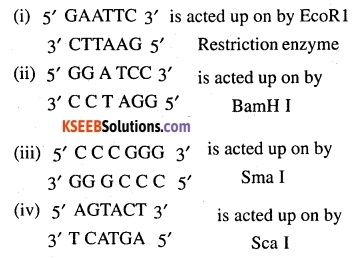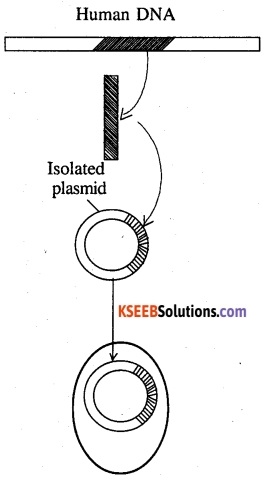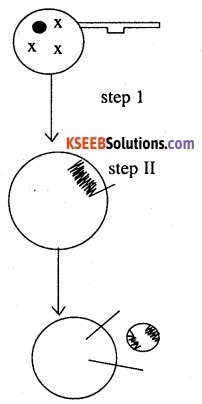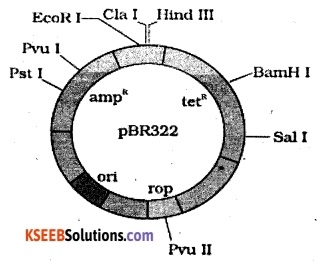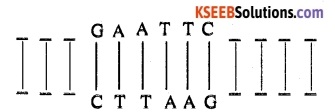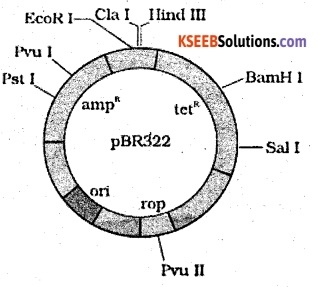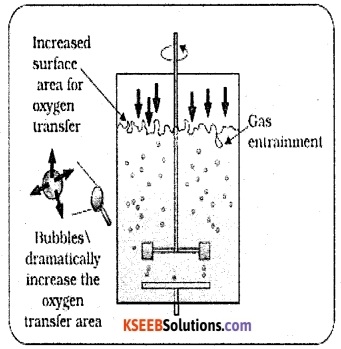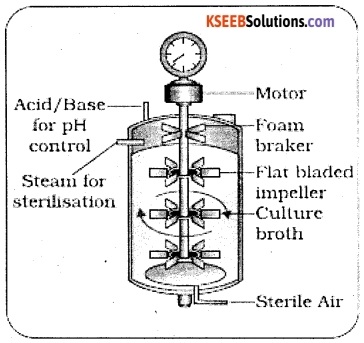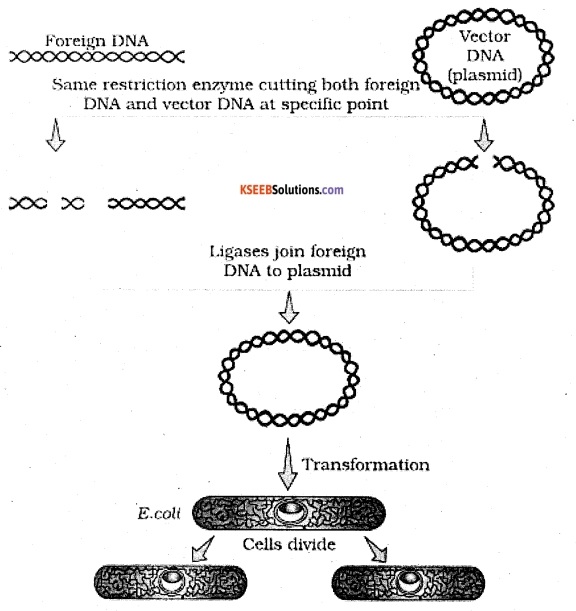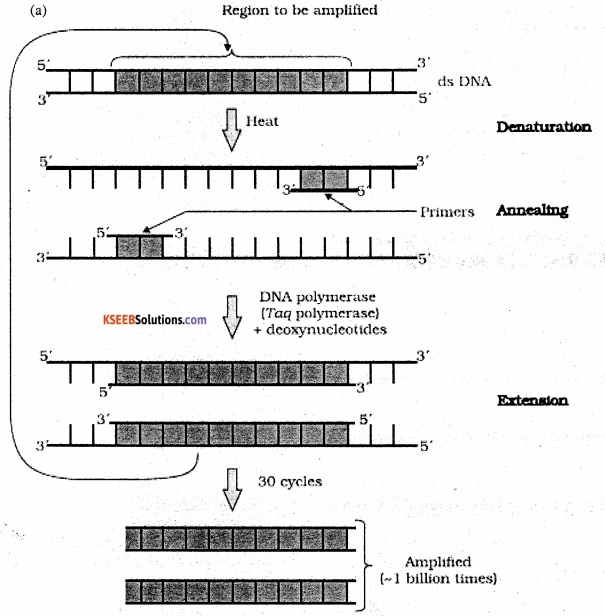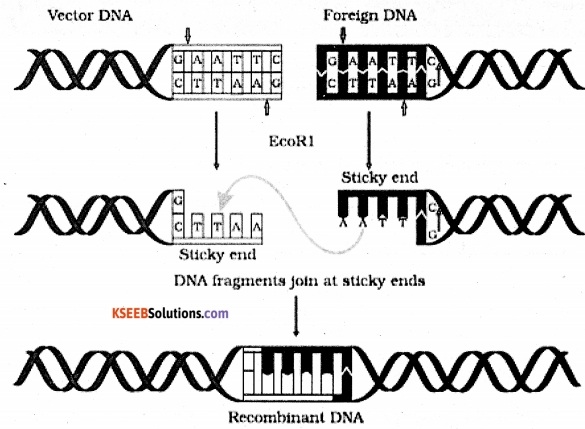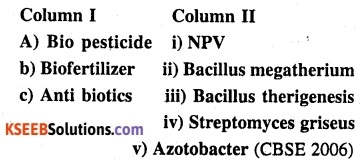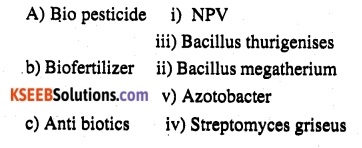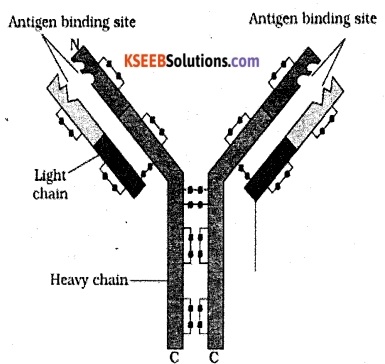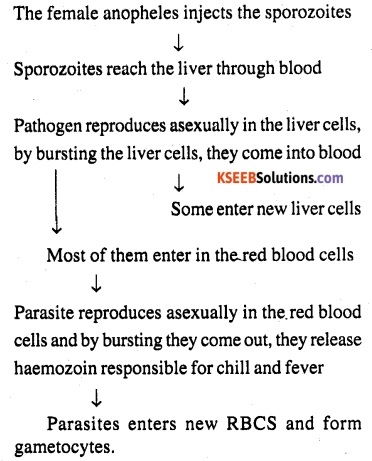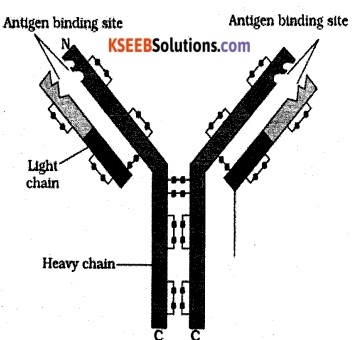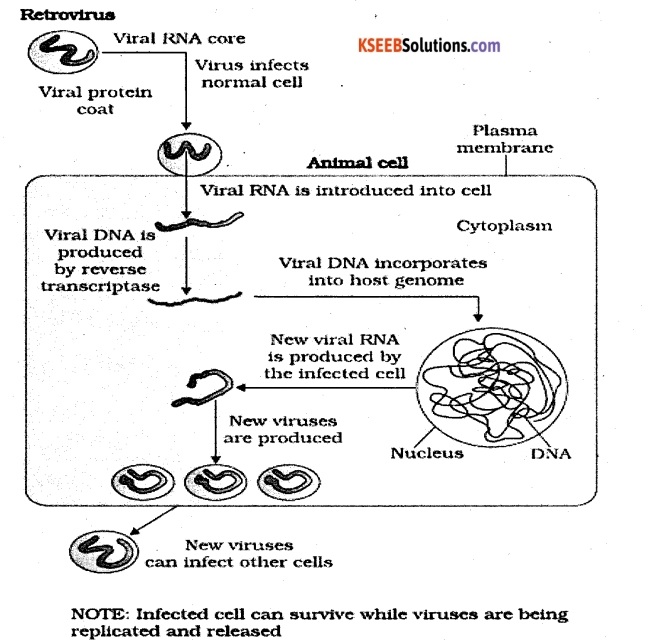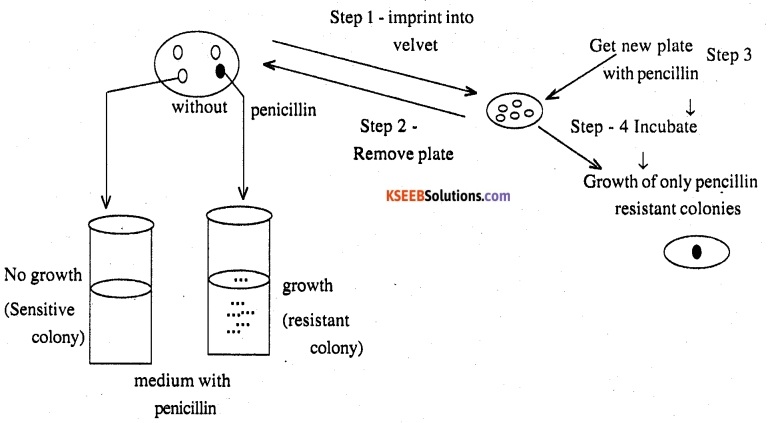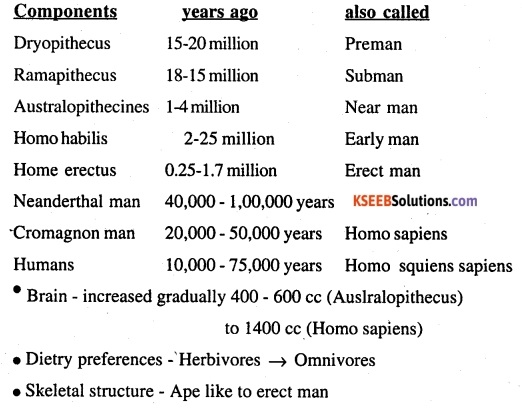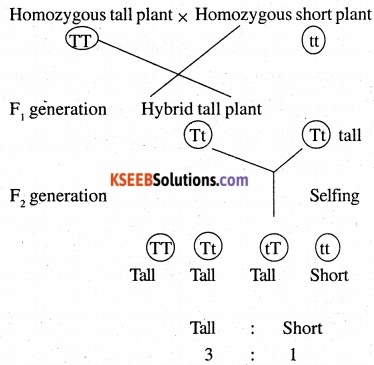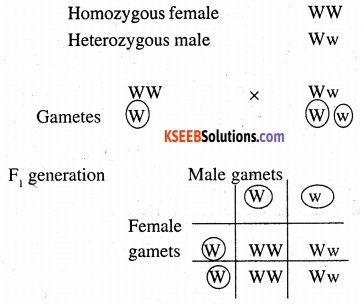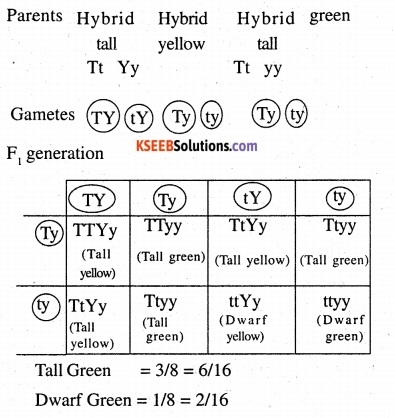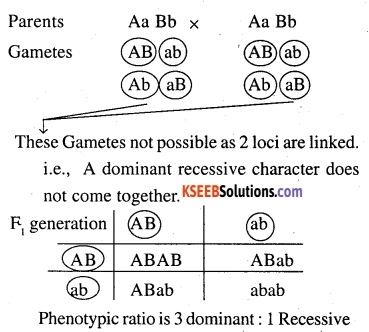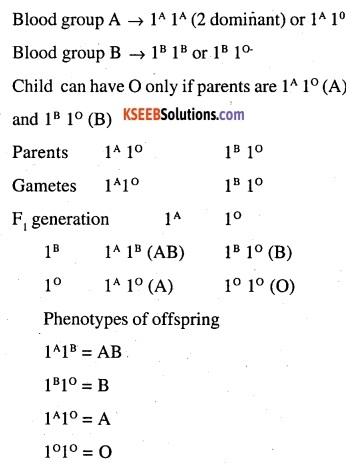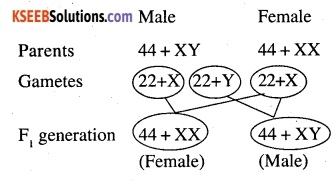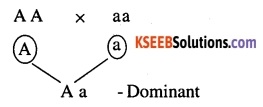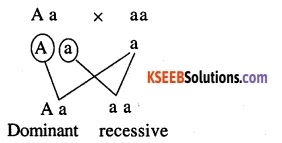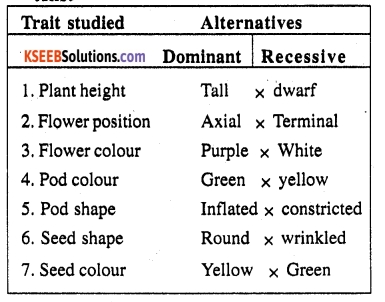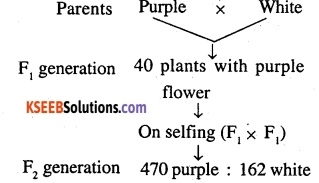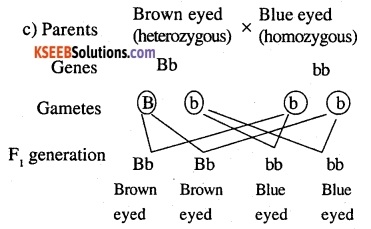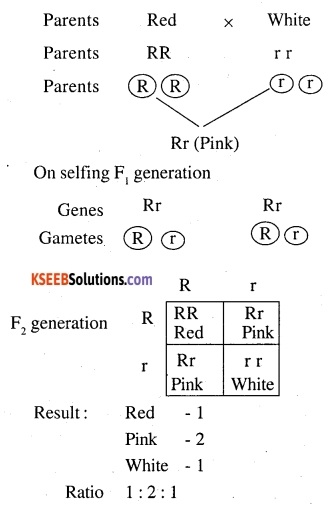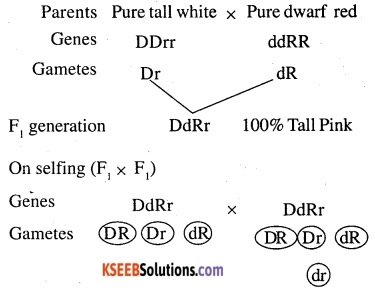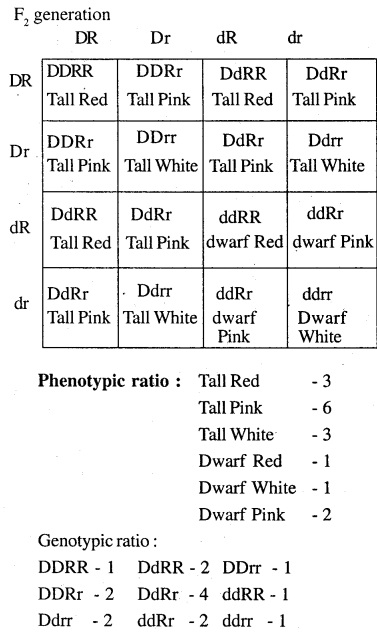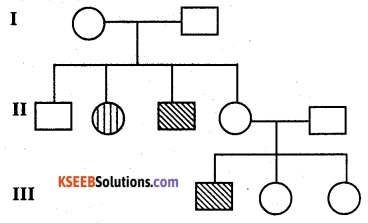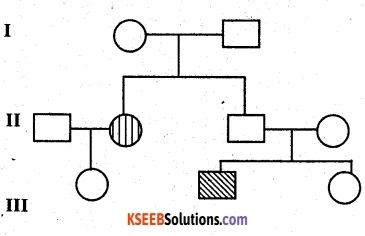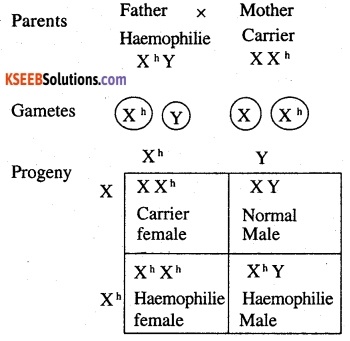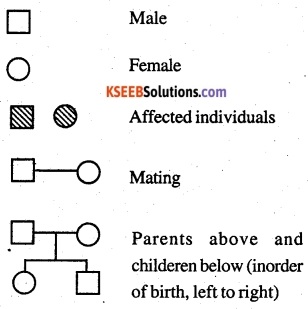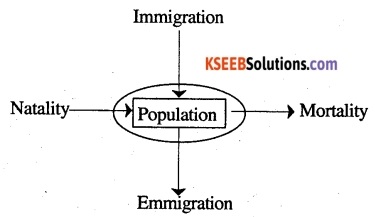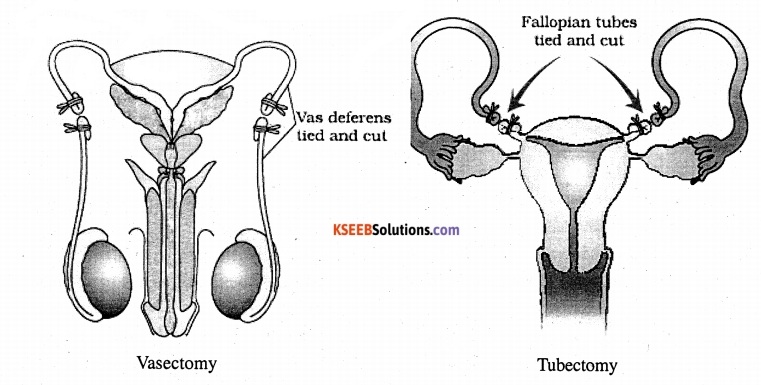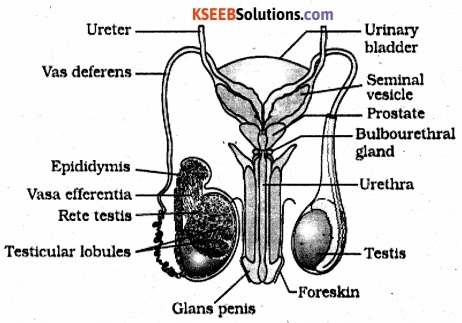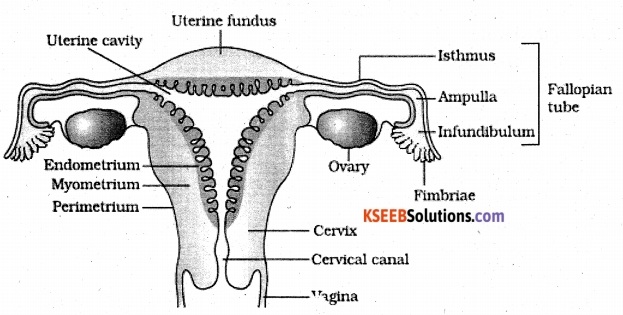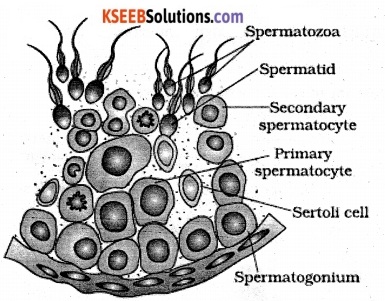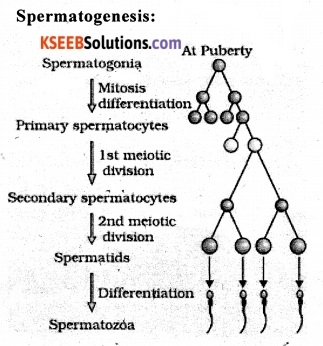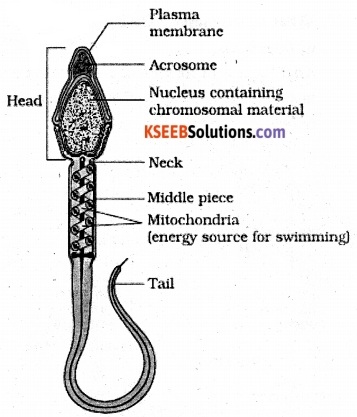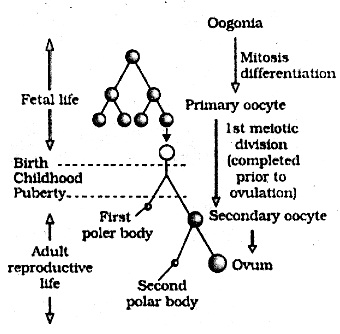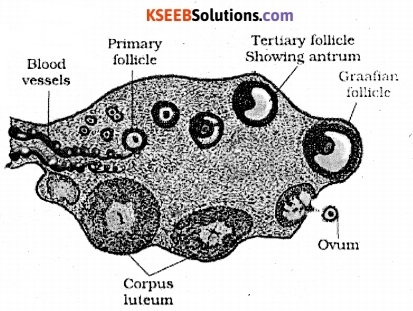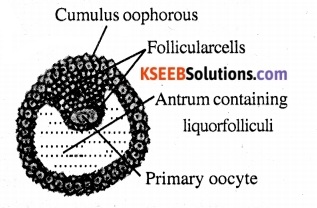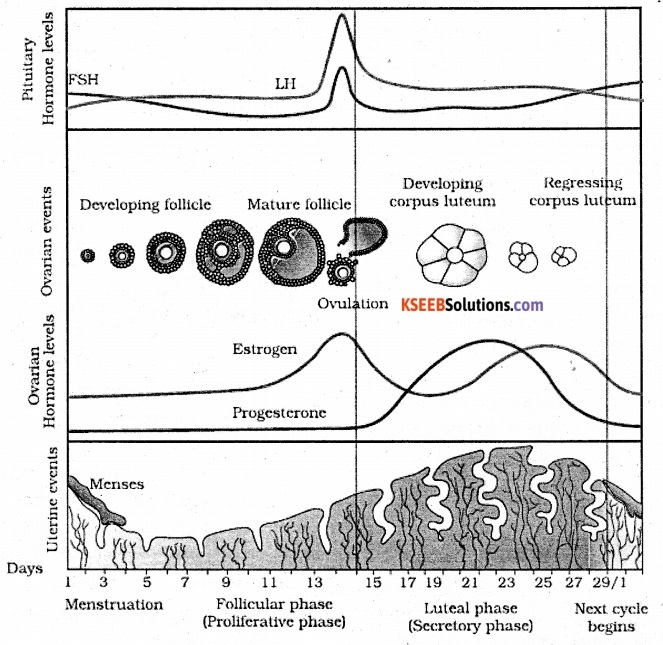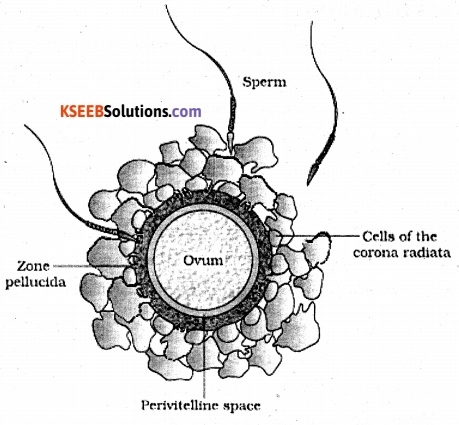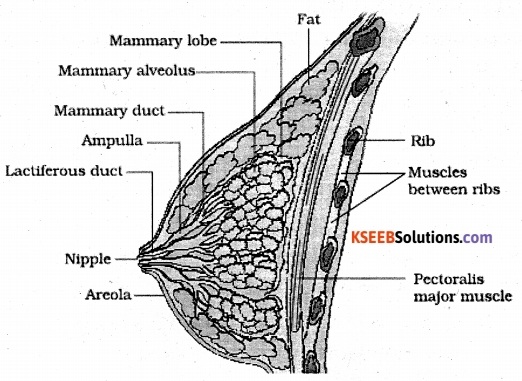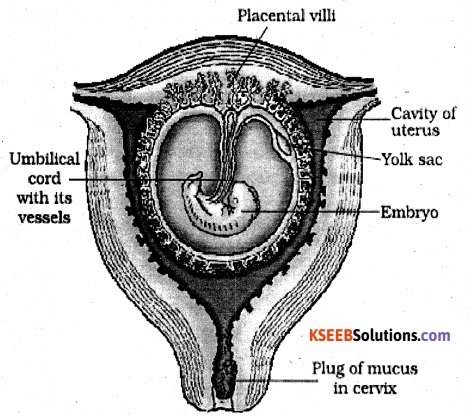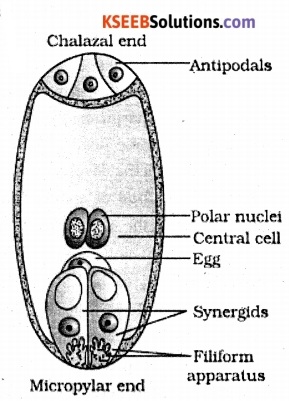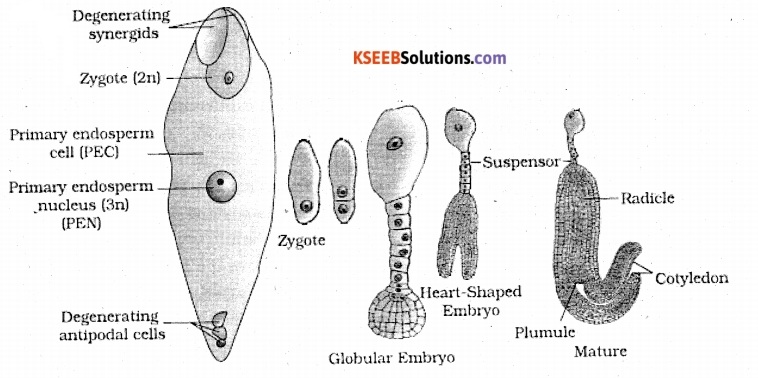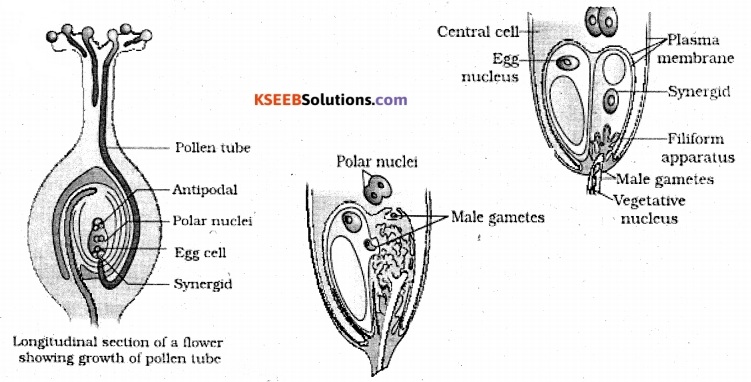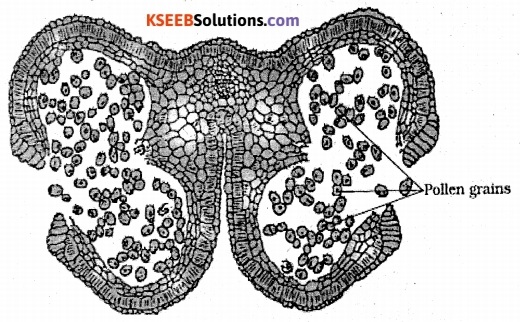You can Download Chapter 12 Biotechnology and its Applications Questions and Answers, 1st PUC Biology Question Bank with Answers, Karnataka State Board Solutions help you to revise complete Syllabus and score more marks in your examinations.
Karnataka 2nd PUC Biology Question Bank Chapter 12 Biotechnology and its Applications
2nd PUC Biology Biotechnology and its Applications Ncert Text Book Questions and Answers
Question 1.
Crystals of Bt toxin produced by some bacteria do not kill the bacteria themselves because
(a) bacteria are resistant to the toxin
(b) toxin is immature;
(c) toxin is inactive;
(d) bacteria encloses toxin in a special sac.
Answer:
(c) Toxin is inactive. This is because it exists as protoxin, inactive form in bacteria.
Question 2.
What are transgenic bacteria? Illustrate using any one example. (CBSE – 2006)
Answer:
Transgenic bacteria are microbes carrying clones of foreign genes. It is also known as genetically modified bacteria.
These bacteria are being employed for many functions .
(a) Two DNA sequence (coding for A and B chains of human insulin) were introduced into the plasmid of bacteria E. Coli. This transgenic bacteria produced insulin chain- Used as biochemical factories
(b) Microbes have been genetically changed to help in cleaning the polluted environment, eg:- Pseudomonas putida for cleaning oil spills pseudomonas species for removing heavy metal pollutants. Aceto bacter aerogans for decomposition of DDT and Flavobacterium for decomposition of 2,4-D.
Question 3.
Compare and contrast the advantages and disadvantages of production of genetically modified crops.
Answer:
Advantages:-
- Crop plants can be made to grow fast and produce high yield through genetic modification.
- G.M crops increased the efficiency of mineral usage by plants.
- G.M crops helped to reduce post harvest losses.
- It enhances the nutritional value of food, eg: Vitamin A enriched rice.
- Transgenic plants can produce pharmaceuticals like insulin, interferons blood clotting factors, hormones etc.
- Resistance to viral diseases has been introduced in Tobacco, potato, tomato and rice. Cry gene from bacillus has been introduced in Bt. cotton and Bt. Corn. Nematode infection has been overcome in some plants through RNA interference.
- Plants have been modified genetically to produced biodiesel and other commercial products.
Disadvantages :-
- G.M. crops may, cause problem in human health by supplying allergens and transferring antibiotic resistance markers.
(b)These crops may came damage to the natural environment. - Weedicide genes are being introduced in to crop plants some of these crop may become super weeds
- Trans genes can be transferred from one plant to another plant, microbes and even animals. It shall disturb the genetic set of organisms and cause ecological imbalance.
- Cry gene being introduced in crop plants can pass into wild vegetation. Insects feeding on pollen and other parts will be killed resulting in destruction of pollination and disseminators.
![]()
Question 4.
What are Cry proteins? Name an organism that produce it. How has man exploited this protein to his benefit?
Answer:
Cry proteins are a group of toxic protein which are highly poisonous to deficient types of insects. It is produced by a soil bacterium Bacillus thuringiensis. The genes controlling their formation are called crygenes eg:- Cry I Ab, Cry I Ac, Cry II Ab, The bacterium produces protein in the crystal form of protoxin. Two cry genes have been incorporated in cotton (Bt cotton) while one has been introduced in corn (Bt corn) As a result Bt Cotton was disease resistance to boll worm and Bt corn was resistance to corn borer.
Question 5.
What is gene therapy? Illustrate using the example of adenosine deaminase (ADA) deficiency,
Answer:
It is the therapeutic treatment of defective heredity by the introduction healthy and functional gene which also silence the defective genes of an individual.
OR
The replacement of a nonfunctional or defective gene with a normal functional gene is called gene therapy. A person with defect in the gene for the enzyme adenosine deaminase (ADA) suffers with SC1D (Severe Combined Immuno Deficiency) The enzyme ADA is crucial for the immune system. Ideally gene therapy should be applied to the zygotes so that the progeny of defective individual also gets rid of effect. It is however, generally applied to somatic cells where the defect occurs.
At first step towards gene therapy, lymphocytes from the blood of the patient are grown in a culture outside the body. A functional ADA cDNA (using a retrovirus vector) is then introduced into these lymphocytes which are subsequently returned to the patient. Since these cells are not immortal, the patient requires periodic infusion of such genetically engineered lymphocytes.
Question 6.
Digrammatically represent the experimental steps in cloning and expressing an human gene (say the gene for growth hormone) into a bacterium like E. coli ?
Answer:
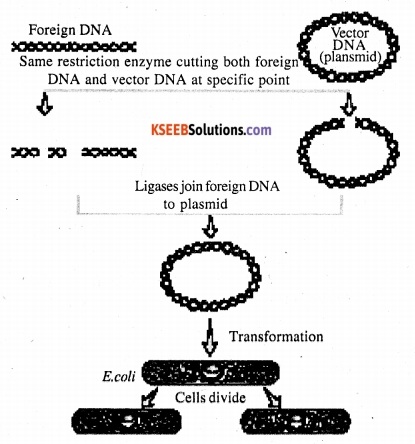
Question 7.
Can you suggest a method to remove oil (hydrocarbon) from seeds based on your understanding of rDNA technology and chemistry of oil?
Answer:
Oil is synthesized by the condensation of 3 fatty acid with a molecule of glycerol. Fatty acids are formed through an enzyme complex called fatty acid synthetase. The oil from the seeds can be removed by preventing the synthesis of either glycerol or the enzyme lipase which catalyses the synthesis of oil. It can be achieved by knocking out the genes coding for the enzyme lipase or the enzyme fatty acid synthetase.
Question 8.
Find out from internet what is golden rice.
Answer:
Golden rice is genetically engineered rice with high vitamin A content.
Question 9.
Does our blood have proteases and nucleases?
Answer:
No, our blood does not contain enzymes proteases and nucleases. If these two enzymes were there in the blood, it causes the degeneration of blood cells and lining cells of blood cells.
Question 10.
Consult internet and find out how to make orally active protein pharmaceutical. What is the major problem to be encountered?
Answer:
Orally active protein can be made through DNA technology for instance, hirudin a blood clotting protein has been produced in the seeds of Brassica napus. The transgenic cow named Rosie contain human protein a lactalbumin. How ever such proteins may cause allergic reaction in some people.
2nd PUC Biology Biotechnology and its Applications Additional Questions and Answers
2nd PUC Biology Biotechnology and its Applications One Mark Questions
Question 1.
Why is the gene encoding Cry protein inserted into crop plant ?
Answer:
When the gene encoding cry protein inserted into a crop plant, the plant becomes resistant to insert pests.
Question 2.
What is the significance of the process of RNA inference (RNAi) in eukaryotic organism. (CBSE 2008)
Answer:
It is a method of cellular defense in eukaryotic organisms, which involves silencing of m.RNA.
Question 3.
State the principle on which ELISA works?
Answer:
The principle is antigen-antibody interaction.
Question 4.
What was the speciality of the milk produced by the transgenic cow, Rosie ? (AI 2008)
Answer:
The milk contained human protein alpha lactalbumin (2.4gm/liter) which is nutritionally important for human babies.
![]()
Question 5.
What is biopiracy?
Answer:
The use of bioresources by multinational companies and other organisation with out proper autherisation from the countries and people concerned.
Question 6.
What GEAC
Answer:
Genetic engineering Approval committee.
Question 7.
What is the role of the organisation GEACf
Answer:
It checks (Delhi 2008)
- The validity of G.M crops
- The safety of introducing genetically modified organisms for public services.
Question 8.
A multinational company outside India tried to sell new verities of turmeric without proper patent rights. What is such an act referred to as?
Answer:
Biopiracy
Question 9.
What is Hirudin ?
Answer:
It is a protein which prevent blood dotting.
2nd PUC Biology Biotechnology and its Applications Two Marks Questions
Question 1.
In case of Bt Cotton how does the toxic insecticide protein produced by bacterium kill the insect pest but not the cells of Bacillus thuringiensis where the toxic protein is generated?
Answer:
The toxin produced by Bacillus thuringiensis is an endotoxin called cry protein. It is crystalline and non toxic when formed being in protoxin stage. As it reaches the gut of insects, the cry protein is converted into toxic ‘ and soluble state. It attaches the receptors present on the epithelial cells of the gut produces pores and kills the cells resulting in death of the insects.
Question 2.
What are 4 main objectives of genetically modified crop plants ? (CBSE 2008)
Answer:
- Higher nutritional value eg: Vitamin. A in golden rice
- Abiotic stresses- Increased tolerance to drought etc.
- Post Harvest losses- Prevention of over-ripening and other post harvest losses.
- Insect and Pest resistance. eg: Bt-cotton.
Question 3.
Define transgenic organisms (CBSE 2006)
Answer:
They are organisms which have been modified genetically through introduction of genes of another organism artificially by the technique of genetic engineering instead of conventional hybridisation.
Question 4.
How is early detection of diseases possible using molecular diagnostics?
Answer:
- Low concentration of viral or bacterial DNA in the host cell/body can be detected much before the symptoms of the disease appear i.e. early detection of disease is possible
- Clones of genes can be used to as probe to detect the presence of mutual alleles in cancer suspected patients.
Question 5.
Name any two biological products that are produced in transgenic animals and mention their uses.
Answer:
- a-1- antitrypsin is used to treat emphysema.
- a – lactalbumin is produced in the milk of the transgenic cow, Rosie, this is nutritionally more balanced product for human babies than normal cow milk.
Question 6.
Give reason for each of the following.
(i) Insulin cannot be administered orally to diabetic patients.
(ii) Biopiracy affects India the most.
Answer:
(i) Insulin in a polypeptide and can be digested by peptidase in the alimentary canal. Hence it cannot be administered orally.
(ii) India is rich in biodiversity and traditional knowledge related to the use of bio-resources, than many other countries, hence it is affected the most with biopiracy.
![]()
Question 7.
What is the cause of adenosine deaminase deficiency in a person?
Answer:
It is due to the deletion of the gene coding for the enzyme adenosine deaminase, this enzyme is crucial for the functioning of the immune system.
Question 8.
Mention the uses of cloned genes in, molecular diagnostics.
Answer:
- Cloned genes are used as probe to detect the presence of its complementary DNA strand; the muted gene will not hybridise with the probe and hence will not appear in the photographic film.
- When cloned genes express themselves and produce recombinant proteins, they help in developing sensitive diagnostic techniques.
Question 9.
Why does Bt toxin not kill the bacillus ? How does it kill the insect larvae ?
Answer:
- When Bt toxin is ingested by an insect, it is converted into its active form when exposed to the alkaline pH in the gut.
- The activated toxin binds to the surface of the epithelial cells of the midgut create pores.
- Water enters the cells and causes their swelling and lysis.
Question 10.
Write the advantages of recombinant therapeutics?
Answer:
The recombinant therapeutics do not induce any unwanted immunological response like the similar products of non human origin such therapeutics are highly effective.
Question 11.
How is ELISA used to detect the pathogens in the body?
Answer:
- Pathogens are detected by the presence of antigens, which may be a protein or glycoprotein.
- Pathogens can be also be detected by the presence of antibodies synthesized against the pathogens.
2nd PUC Biology Biotechnology and its Applications Three Marks Questions
Question 1.
(a) Why is traditional knowledge related to bio-resources exploited ? Give 2 reasons
(b) Name 2 patents on Indian bio-resources that have been revoked.
Answer:
(a) Traditional knowledge is exploited to
- Develop modem applications of the resources
- Save time, effort, expenditure in the process of commercialisation of bio-resources.
(b) The two Indian patents include
- Pesticide property of neem
- Healing and antiseptic property of turmeric.
Question 2.
Mention three reasons for the success of green revolution in India.
Answer:
- Use of improved verities of crops
- Employing better management practice
- Use of agrochemical such as fertilizers and pesticides.
Question 3.
Enumerate the fields of application of biotechnology.
Answer:
The applications of biotechnology include
- Molecular diagnostics
- Bioremediation
- Waste treatment
- Energy production
- Therapeutics.
Question 4.
(a) Write the disadvantages of human use of insulin from other animal sources
(b) What are the concerns about transgenic insulin?
Answer:
(a) Disadvantages
- It causes allergy
- It causes other types of reaction
(b) Concerns about transgenic insulin
- The removal of C-peptide during maturation
- Assembling of the a and p polypeptides together to form mature form of insulin.
Question 5.
Name any 6 plants where Bt toxin producing genes have been included
Answer:
- Cotton
- Tomato
- Rice
- Potato
- Soybean
- Com.
2nd PUC Biology Biotechnology and its Applications Five Marks Questions
Question 1.
Two of the steps involved in producing nematode resistant tobacco plants base of on the process of RNA I are mentioned below. Write the missing steps in the proper sequence.
Answer:

- Nematode specific genes
- Production of both sense and antisense RNAs
- Double strand RNA
- Silencing specific mRNAs of nematode
- Death of nematodes
- Protection of transgenic plants from nematodes.
![]()
Question 2.
Describe by giving one example for each why transgenic animals are produced.
Answer:
- Transgenic animals are designed to allow the study of how genes are regulated and how they affect the normal functions of the body and its development
eq: Information is obtained as to how insulin has a role as growth factor - They are designed to increase our understanding as to how genes could control the development of disease, they serve as models of human disease.
- They produce useful biological compounds created by introducing a portion of the DNA that code for the products.
eg: a-1 antitrypsin is produced for treating emphysema - They are being developed to test the safety vaccines, eg: Polio vaccines has been tested on mice
- Transgenic animals with more sensitivity to toxic substance are being developed to the test the toxicity of drugs.
